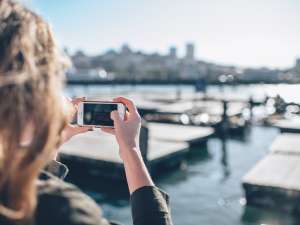
Look at the apps installed on your smartphone and you’ll see that many of them offer location sharing functions. Location sharing is incredibly useful – when used correctly.
Here are a few things you should be aware of
“Check-ins” and strangers
Apps like Foursquare and Swarm encourage users to “check-in” when visiting restaurants, bars and other places of interest. When using these apps, you are encouraged to leave a short review so that other people can decide whether to visit in future.
Swarm also encourages users to create networks of followers who they then compete against, collecting points for every check-in. You can even share these check-ins on other social networks like Twitter and Facebook.
Facebook and Twitter also allow users to share photos, comments and their exact location with status updates. And any of your followers can see these details.
For anyone with a very small social network of people they know and trust, this location sharing isn’t really a problem. But where you have hundreds or thousands of followers who you don’t actually know, sharing this information is less safe.
Potential for crime
For most people, sharing their location is perfectly safe. But the potential for problems does exist.
Burglars have been known to monitor social media for instance. Your holiday snaps taken on the beach on Ibiza are clear evidence that you’re not at home for instance. Which means that your house is empty – a perfect target for a robbery.
As well as knowing where you’re not, location sharing also lets people know exactly where to find you. This is fine for friends and family, but what about jealous ex-partners? Or in the case of children, complete strangers? These people can use your location to meet you for an argument, or perhaps something worse. These incidents are rare, but the risk is real.
Location sharing made safe
The key to sharing your location safely is to limit who can see that information. Rather than broadcasting your location publicly, you should carefully choose who to share with.
Apple
Tools like Apple’s iMessage allow you send pinpoint locations to specific contacts for instance – perfect when you’re trying to organise a meeting, or when one of your friends gets lost on the way. Find My Friends, another Apple app, allows family members and close friends to keep tabs on each other all the time – so long as they agree to sharing their location first.
Android
For Android users, Panda Mobile Security limits sharing personal information through the Privacy Auditor. It shows the permissions required by the apps installed on your device (access to contacts, bank account data, photos, your location, etc.). With a quick look you’ll decide which apps can have access to your location.
Google Maps offers similar functionality – but to maintain your privacy you must set a time limit for sharing. This means your contacts will only see where you are for a few hours or days, reducing the risk of someone you don’t want following you around.
Ultimately, there are four rules you must follow:
- Do not share your location with the general public.
- Always think carefully who else may be following you.
- Regularly check who your location is shared with – and remove permissions for anyone who doesn’t need to know.
- Use privacy-focused apps like iMessage, Find My Friends and Google Maps to ensure your location isn’t exposed to the public.
One final rule of thumb – if you can’t be sure, don’t share.
The post Is it dangerous to share your location on the internet? appeared first on Panda Security Mediacenter.
Source: Panda
